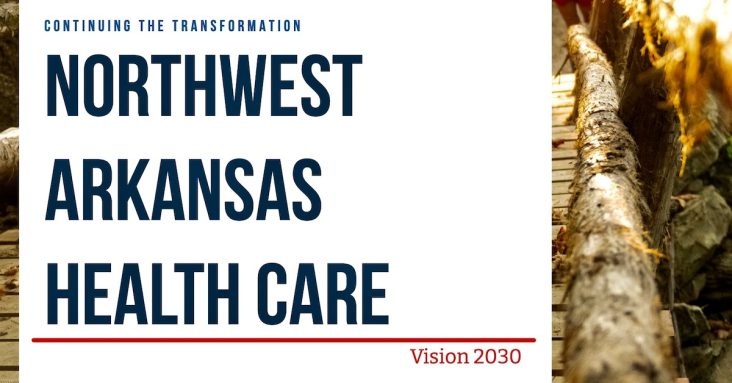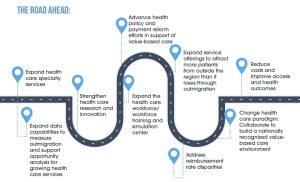Raising low medical reimbursement rates a top focus in Northwest Arkansas
by November 13, 2024 8:02 pm 728 views

The Northwest Arkansas Council on Wednesday (Nov. 13) released a 44-page report that provides a roadmap toward transforming healthcare in Benton and Washington counties, and updated the progress made since the first healthcare report in 2019.
The council’s meeting, held at John Brown University in Siloam Springs, was focused on healthcare, which has been a core element of what the council believes is necessary for the region to continue growing.
Since the creation of the council’s health care transformation division in 2019, significant milestones have been achieved, including reducing outpatient migration from nearly $1 billion in 2018 to $695 million in 2023, the report states. Healthcare infrastructure investments since 2018 through 2023 total more than $529.5 million. There are also an estimated $1.3 billion in planned transformational projects in 2024 that includes the Alice Walton School of Medicine, Heartland Whole Health Institute and seven other expansion projects that advance specialty care. But that’s just a start, according to council leadership.
Paul Umbach, consultant at Tripp Umbach, the firm that helped the council with Wednesday’s report, said despite the progress made there are several challenges standing toward continued progress. He said an estimated 2,000 to 3,000 shortage of healthcare workers, low reimbursement rates from insurers, lack of specialty healthcare, and a lack of funding for expanded graduate medical education represent key challenges.
THE REIMBURSEMENT HURDLE
Perhaps the top of the list is the low reimbursement rate from insurers which is 31% less than the national average. He urged council members to address the big hurdle even though it will take the longest and involves state and federal legislators who need to rewrite the formula for reimbursement rates. Umbach said a better reimbursement rate will help with physician recruitment and retention and encourage more younger people to enter health care professions.

He said the wage index on which Medicare payments are made to health care providers penalizes regions like Northwest Arkansas that provide care at lower costs than other regions. Wage indices fail to account for the actual cost of delivering care, leading to dramatically lower provider payments in Northwest Arkansas compared to Oklahoma City or Kansas City. The report states that reimbursement rate discrepancies greatly impact the profitability of health care providers and make it harder for regions like Northwest Arkansas to attract and retain health care workers.
Umbach said the federal reimbursement rate in Arkansas is among the lowest in the country and yet the Natural State also ranks among the sickest in terms of chronic care needs. A Northwest Arkansas hospital would receive $5,725 less per patient for the same medical procedure done in Oklahoma City. At $8,842.50, the Arkansas average patient reimbursement rate is $8,504 less than in Texas, $3,146 less than in Louisiana, $3,675 less than in Mississippi, $2,925 less than in Missouri, and $4,839 less than in Tennessee.
“Arkansas gets the least amount of reimbursement and health-wise the state is also among the sickest with regard to chronic disease,” he said.
Umbach said there is other lower hanging fruit the region could pick first, but until the reimbursement rate is addressed by state and federal governments, it will be nearly impossible for the region to complete its healthcare transformation goals.
“Northwest Arkansas is a center of excellence for logistics, retail and engineering and the region figured out how to attain that. Health care is the most intimate thing we can talk about. Behind the leadership of the Heartland Whole Health Institute and top employers in the region a move toward value-based care is also a top priority,” Umbach noted.
RESEARCH FUNDING, SPECIALTY CARE
He said the University of Arkansas is also behind in National Institutes of Health (NIH) funding and other government grants which can further health science center excellence. He said UA received only $12.3 million this year, but the University of Arkansas for Medical Sciences (UAMS) received $70.8 million, most of which stayed in Little Rock.
The UA expanded its biomedical research and investments facilities since 2018 in the effort to receive more NIH funding. Northwest Arkansas received $15.7 million in NIH funding in 2024 which was more than peer cities of Austin, Texas, Des Moines, Iowa, Boise, Idaho, and Evansville, Ind. The amount is still woefully below the $48.5 million received by Spokane, Wash., or $425 million at Madison, Wisc., or $1.626 billion at Chapel Hill, N.C.
Umbach said collaborations between Highlands Oncology, UAMS Northwest, Alice Walton School of Medicine (AWSOM) and Heartland Whole Health Institute are in their early stages but will lay the groundwork for future research capacity and funding.
To become a health center of excellence, Northwest Arkansas will have to establish more specialty care. Heart disease is a particular focus because it is the leading cause of death among Arkansans and because cardiology is the most in-demand type of specialty care.
Arkansas ranks 42nd in terms of the number of cardiologists per capita. The recent collaboration between AWSOM, Heartland Whole Health Institute and Mercy with the Cleveland Clinic is a significant step toward addressing the needs. The collaboration emphasizes the development of residencies in cardiology and related subspecialties to help alleviate the shortage of medical professionals.
TRAUMA CARE
Umbach said partnerships are one way the region can address specialty needs. Another area of concern is lack of a Level 1 trauma hospital within an hour of Northwest Arkansas. The closest facility is 130-miles away in Springfield, Mo. Little Rock is 180 miles away and the second closest.
Washington Regional Medical Center is the only Level 2 trauma facility in the region and to become a Level 1 center it must have 1,200 trauma admissions per year, average 35 trauma patients per surgeon, offer a residency in trauma surgery and undergo a review every three years.
Dr. Larry Shackleford, CEO of Washington Regional Medical Center, is working to expand residency training slots and extend graduate medical education programs but said the lack of funding is a bigger issue.
Shackleford asked Umbach about additional funding sources during the question-and-answer session of the meeting. Umbach said government funding is hard to secure, but endowments, philanthropy, industry sponsorships and even tax funding have worked in peer cities. He said one-quarter of graduate medical education funding comes from private donors. With the lowest reimbursement rate in the nation, local hospitals simply do not have the extra funds to support graduate medical education programs by themselves, Umbach said.
“There is no easy way to reach the goals set out in the plan, but it’s important to start today because as fast as the region is growing, the needs will only get bigger,” Umbach said.
Link here for a PDF of the 44-page report. (The PDF includes a note about the Highlands Oncology cancer center in Rogers having an estimated cost of $7.5 million. The correct estimated cost is $75 million.)
